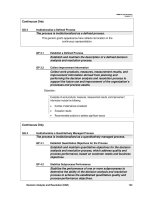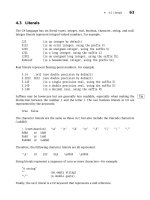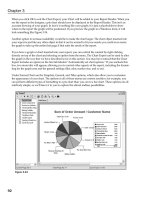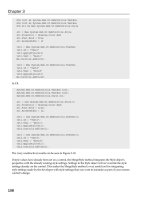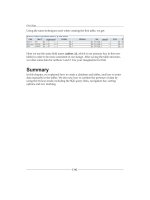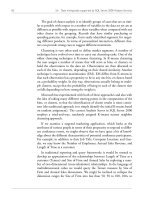Financial Toolbox For Use with MATLAB Computation Visualization Programming phần 4 pdf
Bạn đang xem bản rút gọn của tài liệu. Xem và tải ngay bản đầy đủ của tài liệu tại đây (176.74 KB, 40 trang )
bdtbond
2-22
VolatilityCurve
(required) Curve of instantaneous yearly
volatilities of the short rates.The curve is
interpolated to cover the time span of the bond.
VolatilityCurve.CurveDates: (required)
NCURVE2-by-1 vector of serial dates.
VolatilityCurve.VolatilityRates: (required)
NCURVE2-by-1 vector of yearly volatilities in
decimal form.
Accuracy
(required) Scalar that specifies the number of
steps in the tree per coupon period. Larger
numbers yield more accurate answers, but require
more time and memory.
CreditCurve
(optional) Curve of rate spreads arising from
default risk. The curve has
NCURVE3 (date, basis
point) pairs.The curve is interpolated to cover the
time span of the bond.
CreditCurve.CurveDates:(required)
NCURVE3-by-1 vector of serial dates.
CreditCurve.CreditRates: (required)
NCURVE3-by-1 vector of credit spread values in
basis points (not decimal rates). The effective
change to the zero rate is
CreditRates/10000.
ComputeSensitivity
(optional) Specify if bond sensitivity measures
(with and without options) are to be computed.
1
indicates measure computed; 0 indicates not
computed. Sensitivities found by a finite
difference calculation. The default is no
sensitivities, only prices returned.
ComputeSensitivity.Duration: (required) scalar
1 or 0.
ComputeSensitivity.Convexity: (required)
scalar
1 or 0.
ComputeSensitivity.Vega: (required) scalar 1 or
0.
bdtbond
2-23
Description [Price, Sensitivities, DiscTree, PriceTree] = bdtbond(OptBond,
ZeroCurve, VolatilityCurve, Accuracy, CreditCurve,
ComputeSensitivity) computes price and sensitivity measures of a bond with
embedded call or put options. Valuation is based on the Black-Derman-Toy
model for pricing interest rate options given an input yield curve (and possibly
a credit spread) and volatility curve.
Price is the value of the bond with and without the options.
Price.OptionFreePrice: Scalar price of the bond without any options.
Price.OptionEmbedPrice: Scalar price (value to the holder of the bond) of the
bond with options.
Price.OptionValue: scalar value of the options to the holder of the bond .
Sensitivities refer to the effect that changes in the yield curve and volatility
term structure have on option-free and option-embedded bond prices.
Sensitivities.Duration: Sensitivity of option-free bond price to parallel
shifts of the yield curve.
Sensitivities.EffDuration: Sensitivity of the option-embedded price to
shifts in the yield curve.
Sensitivities.Convexity: Sensitivity of Duration to shifts in the yield curve.
Sensitivities.EffConvexity: Sensitivity of EffDuration to shifts in the yield
curve.
Sensitivities.Vega: Sensitivity of the option-embedded price to parallel
shifts of the volatility curve.
DiscTree is the recombining binomial tree of the interest rate structure. The
tree covers
NPERIODS times from Settlement to Maturity, where there are
Accuracy steps in each coupon period. The short rate at settlement and
between settlement and the first time is deterministic.
DiscTree.Values: NSTATES-by-NPERIODS matrix of short discount factors. The
NPERIODS columns of Values correspond to successive times. The NSTATES rows
correspond to states in the rate process. Unused states are masked by
NaN.
bdtbond
2-24
Multiplication of a cash amount at time Dates(i) by the discount Values(j,i)
gives the price at Dates(i-1) after traversing the (j,i) edge of the tree. The
short rate
R(j,i) prevailing at node (j,i) satisfies:
( 1 + R(j,i)/Frequency)^(-(Times(j)-Times(j-1))) = Values(j,i)
DiscTree.Times
: 1-by-NPERIODS vector of tree node times in units of coupon
intervals. (Type
help ftbTFactors for more information.)
DiscTree.Dates: 1-by-NPERIODS vect or of tr ee node ti m es a s serial date
numbers.
DiscTree.Type:'Short Discount'
DiscTree.Frequency
: Compounding frequency of the input bond.
DiscTree.ErrorFlag: (0 or 1). Set to 1 if any short rate becomes negative.
PriceTree is the recombining binomial tree of cash amounts at tree nodes.
PriceTree is computed from the bond cash flows and the option payoffs. The
clean price of t he bond is the
PriceTree value minus the coupon payment and
the accrued interest.
PriceTree.Values: NSTATES-by-NPERIODS matrix of price states.
PriceTree.Times: 1-by-NPERIODS vector of tree node times in units of coupon
intervals. (Type
help ftbTFactors for more information.)
PriceTree.Dates: 1-by-NPERIODS vecto r of t r ee nod e time s as serial date
numbers.
PriceTree.AccrInt: 1-by-NPERIODS vector of accrued interest payable at each
time.
PriceTree.Coupons: 1-by-NPERIODS vector of coupon payments at each time.
DiscTree.Type:'Price'
Example Given a bond with the characteristics
OptBond.Settle = '15-Jul-1996';
OptBond.Maturity = '15-Jan-1998';
OptBond.CouponRate = 0.06;
OptBond.Period = 2
bdtbond
2-25
Specify an American put option on the bond. Make the bond putable by the
holder between 15-Jan-1997 and maturity for a strike of 98.
OptBond.PutType = 1;
OptBond.PutStartDate = '15-Jan-1997';
OptBond.PutExpiryDate = '15-Jan-1998';
OptBond.PutStrike = 98
Build zero curve t erm structure.
ZeroCurve.ZeroRates = [0.05; 0.06; 0.065];
ZeroCurve.CurveDates = ['01-Jan-1996'; '01-Jan-1997';
'01-Jan-1998']
Build volatility curve term structure.
VolCurve.VolatilityRates = [0.15; 0.13];
VolCurve.CurveDates = [729025; 729756]
The coupon interval is 1/2 year; use 10 tree periods per year.
Accuracy = 5
Specify a constant credit spread of 200 basis points (0.02).
CreditCurve.CreditRates = [200];
CreditCurve.CurveDates = ['01-Jan-1996']
bdtbond
2-26
Ask for duration and vega.
SensChoice.Duration = 1;
SensChoice.Convexity = 0;
SensChoice.Vega = 1;
[Price, Sensitivities, DiscTree, PriceTree] =
bdtbond(OptBond, ZeroCurve, VolCurve, Accuracy, CreditCurve,
SensChoice);
Price =
OptionFreePrice: 96.5565
OptionEmbedPrice: 97.1769
OptionValue: 0.6204
Sensitivities =
Duration: 1.3959
EffDuration: 0.6848
Convexity: NaN
EffConvexity: NaN
Vega: -0.0194
To look at the rate and clean price trees, use the bdttrans function.
bdttrans(DiscTree)
bdttrans(PriceTree)
See Also bdttrans
bdttrans
2-27
2bdttrans
Purpose Translate a tree returned by bdtbond.
Syntax bdttrans(Tree)
[TreeMat, TreeTimes] = bdttrans(Tree)
Arguments
Description
bdttrans unpacks and converts a Short Discount tree structure to a Short
Ratetree,oraPricetreestructuretoaCleanPricetree.Theoutputisamatrix
of tree node values and a vector of node times.
TreeMat is an NSTATES-by-NTIMES converted matrix of Short Rate or Clean
Price values at points on t he t ree. T ime layers are columns containing the
different states. Unused entries of the matrix a re screened with
NaNs
TreeTimes is a 1-by-NTIMES vector of times corresponding to layers of TreeMat.
If
bdttrans is called witho ut output arg uments, it plots the translated tree
against the time axis in coupon intervals.
Example Specify a bond.
OptBond.Settle = '15-Jul-1996';
OptBond.Maturity = '15-Jan-1998';
OptBond.CouponRate = 0.07;
OptBond.Period = 2;
Specify an embed ded American call option. Mak e t he bond ca llable by the
issuer between 15-Jan-1997 and maturity.
OptBond.CallType = 1;
OptBond.CallStartDate = '15-Jan-1997';
OptBond.CallExpiryDate = '15-Jan-1998';
OptBond.CallStrike = 101;
Build constant zero curve structure.
ZeroCurve.ZeroRates = 0.05;
ZeroCurve.CurveDates = '15-Jul-1996';
Tree
Tree structure returned by bdtbond.
bdttrans
2-28
Build constant volatility curve structure.
VolCurve.VolatilityRates = 0.15;
VolCurve.CurveDates = '15-Jul-1996';
Choose two tree nodes per whole coupon period.
Accuracy = 2;
Run the bdtbond function.
[Price, Sensitivities, DiscTree, PriceTree] = bdtbond(OptBond,
ZeroCurve, VolCurve, Accuracy);
Convert the discount tree to a short rate tree.
DiscTree =
Values: [6x7 double]
Times: [0 0.5000 1 1.5000 2 2.5000 3]
Dates: [729221 729313 729405 729496 729586 729678 729770]
ErrorFlag: 0
Type: 'Short Discount'
Frequency: 2
[ShortRateMat, TreeTimes] = bdttrans(DiscTree)
ShortRateMat =
TreeTimes =
0 0.5000 1.0000 1.5000 2.0000 2.5000 3.0000
0.0500 0.0500 0.0447 0.0399 0.0357 0.0319 0.0285
NaN
NaN
0.0554 0.0494 0.0442 0.0395 0.0353
NaN NaN NaN
0.0613 0.0548 0.0489 0.0437
NaN NaN NaN NaN
0.0679 0.0607 0.0542
NaN NaN NaN NaN NaN
0.0753 0.0672
NaN NaN NaN NaN NaN NaN
0.0835
bdttrans
2-29
ConvertthePricetreetoaCleanPricetree.
PriceTree =
Values: [6x7 double]
Times: [0 0.5000 1 1.5000 2 2.5000 3]
Dates: [729221 729313 729405 729496 729586 729678 729770]
ErrorFlag: 0
AccrInt: [0 1.7500 0 1.7597 0 1.7500 0]
Coupons: [0 0 3.5000 0 3.5000 0 3.5000]
Type: 'Price'
[CleanPriceMat, TreeTimes] = bdttrans(PriceTree)
CleanPriceMat =
TreeTimes =
0 0.5000 1.0000 1.5000 2.0000 2.5000 3.0000
See Also bdtbond
101.9512 101.4677 101.0000 101.0000 101.0000 100.9348 100.0000
NaN
NaN
101.0000 101.0000 101.0000 100.7429 100.0000
NaN NaN NaN
100.6019 100.7397 100.5060 100.0000
NaN NaN NaN NaN
100.0978 100.2139 100.0000
NaN NaN NaN NaN NaN
99.8539 100.0000
NaN NaN NaN NaN NaN NaN
100.0000
beytbill
2-30
2beytbill
Purpose Bond equivalent yield for Treasury bill.
Syntax y = beytbill(sd, md, disc)
Arguments sd Settlement date. Enter as serial date number or date string. sd must
be earlier than or equal to
md.
md Maturity date. Enter as serial date number or da te string.
disc Discount rate of the Treasury bill. Enter as decimal fraction.
Description y = beytbill(sd, md, disc) returns the bond equivalent yield for a
Treasury bill.
Example The settlement date of a Treasury bill is February 10, 1992, the maturity date
is August 6, 1992, and the discount rate is 3.77%. The bond equivalent yield:
y = beytbill('2/10/1992', '8/6/1992', 0.0377)
y =
0.0389
See Also datenum, prtbill, yldtbill
binprice
2-31
2binprice
Purpose Binomial put and call pricing.
Syntax [pr, opt] = binprice(so, x, r, t, dt, sig, flag, q, div, exdiv)
Arguments so Underlying asset price. A scalar.
x Option exercise price. A scalar.
r Risk-free interest rate. A scalar. Enter as a decimal fraction.
t The option’s time until maturity in years. A scalar.
dt The time increment wit hin t. A scalar. dt is adjusted so that the length
of each interval is consistent with the maturity time of the option. (
dt is
adjusted so that
t divided by dt equals an integer number of
increments.)
sig The asset’s volatility. A scalar.
flag Specifies whether the option is a call (flag = 1)oraput(flag = 0). A
scalar.
q The dividend rate, as a decimal fraction. A scalar. Default = 0.Ifyou
enter a value for
q,setdiv and exdiv = 0 or do not enter them. If you
enter values for
div and exdiv,setq=0.
div The dividend payment at an ex-dividend date, exdiv. A 1-by-N vector.
For each dividend p ayment, there must be a corre sponding ex- dividend
date. Default =
0. If you enter val ues for div and exdiv,setq=0.
exdiv Ex-dividend date, specified in number of periods. A 1-by-N vector.
Default =
0.
Description [pr, opt] = binprice(so, x, r, t, dt, sig, flag, q, div, exdiv)
prices an option using a binomial pricing model.
Example For a put option, the asset price is $52, option exercise price is $50, risk-free
interest rate is 10%, option matures in 5 months, volatility is 40%, and there is
one dividend payment of $2.06 in 3-1/ 2 months:
[pr, opt] = binprice(52, 50, 0.1, 5/12, 1/12, 0.4, 0, 0, 2.06, 3.5)
binprice
2-32
returns the asset price and option value at each node of the binary tree:
pr =
52.0000 58.1367 65.0226 72.7494 79.3515 89.0642
0 46.5642 52.0336 58.1706 62.9882 70.6980
0 0 41.7231 46.5981 49.9992 56.1192
0 0 0 37.4120 39.6887 44.5467
0 0 0 0 31.5044 35.3606
0 0 0 0 0 28.0688
opt =
4.4404 2.1627 0.6361 0 0 0
0 6.8611 3.7715 1.3018 0 0
0 0 10.1591 6.3785 2.6645 0
0 0 0 14.2245 10.3113 5.4533
0 0 0 0 18.4956 14.6394
0 0 0 0 0 21.9312
See Also blkprice, blsprice
Reference Hull, Options, Futures, and Other Derivative Securities, 2 nd edition, Chapter 14.
blkprice
2-33
2blkprice
Purpose Black’s option pricing.
Syntax [call, put] = blkprice(f, x, r, t, sig)
Arguments f Forward price of underlying asset at time zero. Must be greater than 0.
You can extend Black’s model to interest-rate derivatives (call and put
options embedded in bonds) by calculating the forward price from the
equation
f = (B - I) * exp(r*t)
where B is the face value of the bond and I is the pres ent value of the
coupons during the life of the option.
x Strike or exercise price of the options. Must be greater than 0.
r Risk-free interest rate (plus storage costs less any convenience yield).
Must be greater than or equal to 0.
t Time until maturity of option in years. Must be greater than 0.
sig Volatility of the price of the underlying asset. Must be greater than or
equal to 0.
Description [call, put] = blkprice(f, x, r, t, sig) uses Black’s model to value an
option and returns the
call and put option prices.
Note: This function uses normcdf, the normal cumulative distribution
function in the Statistics Toolbox.
Example The forward price of a bond is $95, the exercise price of the option is $98, the
risk-free interest rate is 11%, the time to maturity of the option is 3 years, and
the volatility of the bond price is 2.5%.
[call, put] = blkprice(95, 98, 0.11, 3, 0.025)
call =
0.4162 (or $0.42)
put =
2.5729
(or $2.57)
blkprice
2-34
References Hull, Options, Futures, and Other Derivative S ecurities, 2nd edition, Formulas
15.7 and 15.8.
Black, “The Pricing of Commodity Contracts,” Journal of Financial Economics,
March 3, 1976, pp. 167-179.
See Also binprice, blsprice
blsdelta
2-35
2blsdelta
Purpose Black-Scholes sensitivity to underlying price change.
Syntax [cd, pd] = blsdelta(so, x, r, t, sig, q)
[cd, pd] = blsdelta(so, x, r, t, sig)
Arguments so Current stock price.
x Exercise price.
r Risk-free interest rate. Enter as a decimal fraction.
t Time to maturity of the option, in years.
sig Standard deviation of the annualized continuously compounded rate of
return of the stock, also known as volatility.
q Dividend rate or foreign interest rate where applicable. Enter as a
decimal fraction. Default =
0.
Description [cd, pd] = blsdelta(so, x, r, t, sig, q) returns sensitivity in option
value to change in the underlying security price. Delta is also known as the
hedge ratio.
cd is the delta of a call option, and pd is the delta of a put option.
Note: This function uses normcdf, the normal cumulative distribution
function in the Statistics Toolbox.
Example [cd, pd] = blsdelta(50, 50, 0.1, 0.25, 0.3, 0)
cd =
0.5955
pd =
-0.4045
See Also blsgamma, blslambda, blsprice, blsrho, blstheta, blsvega
Reference Hull, Options, Futures, and Other Derivative Securities, 2nd edition, Chapt e r 1 3.
blsgamma
2-36
2blsgamma
Purpose Black-Scholes sensitivity to underlying delta change.
Syntax g = blsgamma(so, x, r, t, sig, q)
g = blsgamma(so, x, r, t, sig)
Arguments so Current stock price.
x Exercise price.
r Risk-free interest rate. Enter as a decimal fraction.
t Time to maturity of the option in years.
sig Standard deviation of the annualized continuously compounded rate of
return of the stock (also known as the volatility).
q Dividend rate. Enter as a decimal fraction. Default =0.
Description g = blsgamma(so, x, r, t, sig, q) returns gamma g, the sensitivity of
delta to change in the underlying security price.
Note: This function uses normpdf, the normal probability density function in
the Statistics Toolbox.
Example g = blsgamma(50, 50, 0.12, 0.25, 0.3, 0)
g =
0.0512
See Also blsdelta, blslambda, blsprice, blsrho, blstheta, blsvega
Reference Hull, Options, Futures, and Other Derivative Securities, 2 nd edition, Chapter 13.
blsimpv
2-37
2blsimpv
Purpose Black-Scholes implied volatility.
Syntax v = blsimpv(so, x, r, t, call, maxiter)
v = blsimpv(so, x, r, t, call)
Arguments so Current asset price.
x Exercise price.
r Risk-free interest rate. Enter as a decimal fraction.
t Time to maturity in years.
call Call option value.
maxiter Maximum number of iterations used in solving for v using Newton’s
method. Default =
50.
Description v = blsimpv(so, x, r, t, call, maxiter) returns the implied volatility v
of an underlying asset, using Newton’s method.
Note: This function uses normcdf and normpdf, t he normal cumulative
distribution and normal probability density functions in the Statistics
Toolbox.
Example An asset has a current price of $100, an exercise price of $95, the risk free
interest rate is 7.5%, the time to maturity of the option is 0.25 years, and the
call option has a value of $10.00.
v = blsimpv(100, 95, 0.075, 0.25, 10)
v =
0.3130
(or 31.3%)
See Also blsprice
Reference Bodie, Kane, and Marcus, Investments, page 681.
blslambda
2-38
2blslambda
Purpose Black-Scholes elasticity.
Syntax [lc, lp] = blslambda(so, x, r, t, sig, q)
[lc, lp] = blslambda(so, x, r, t, sig)
Arguments so Current stock price.
x Exercise price.
r Risk-free interest rate. Enter as a decimal fraction.
t Time to maturity of the option in years.
sig Standard deviation of the annualized continuously compounded rate of
return of the stock (also known as the volatility).
q Dividend rate. Enter as a decimal fraction. Default =0.
Description [lc, lp] = blslambda(so, x, r, t, sig, q) returns the elast icity of an
option.
lc is the call option elasticity or leverage factor, and lp is the put option
elasticity or leverage factor. Elasticity (the leverage of an option position)
measures the percent change in an option price per one percent change in the
underlying stock price.
Note: This function uses normcdf, the normal cumulative distribution
function in the Statistics Toolbox.
Example [lc, lp] = blslambda(50, 50, 0.12, 0.25, 0.3)
lc =
8.1274
lp =
-8.6466
See Also blsdelta, blsgamma, blsprice, blsrho, blstheta, blsvega
Reference Daigler, Advanced Options Trading,Chapter4.
blsprice
2-39
2blsprice
Purpose Black-Scholes put and call pricing.
Syntax [call, put] = blsprice(so, x, r, t, sig, q)
[call, put] = blsprice(so, x, r, t, sig)
Arguments so Current asset price.
x Exercise price.
r Risk-free interest rate. Enter as a decimal fraction.
t Time to maturity of the option in years.
sig Standard deviation of the annualized continuously compounded rate of
returnoftheasset(alsoknownasthevolatility).
q Dividend rate of the asset. Enter as a decimal fraction. Default =0.
Description [call, put] = blsprice(so, x, r, t, sig, q) returns the value of call
and put options using the Black-Scholes pricing formula.
Note: This function uses normcdf, the normal cumulative distribution
function in the Statistics Toolbox.
Example The current price of an asset is $100, the exercise price of the option is $95, the
risk-free interest rate is 10%, the time to maturity of the option is 0.25 years,
and the standard deviation of the asset is 50%.
[call, put] = blsprice(100, 95, 0.1, 0.25, 0.5)
call =
13.70
put =
6.35
See Also blkprice, blsdelta, blsgamma, blsimpv, blslambda, blsrho, blstheta,
blsvega
Reference Bodie, Kane, and Marcus, Investments, page 681.
blsrho
2-40
2blsrho
Purpose Black-Scholes sensitivity to interest rate change.
Syntax [cr, pr]= blsrho(so, x, r, t, sig, q)
[cr, pr]= blsrho(so, x, r, t, sig, q)
Arguments so Current security price.
x Exercise or strike price.
r Interest rate. Enter as a decimal fract ion.
t Time to maturity of the option in years.
sig Standard deviation of the annualized continuously compounded rate of
return of the security (also known as the volatility).
q Dividend rate of the s ecurity. Enter a s a decimal fraction. Default =0.
Description [cr, pr]= blsrho(so, x, r, t, sig, q) returns the call option rho cr,
andtheputoptionrho
pr. Rho is the rate of change in value of securities with
respect to interest rates.
Note: This function uses normcdf, the normal cumulative distribution
function in the Statistics Toolbox.
Example [cr, pr] = blsrho(50, 50, 0.12, 0.25, 0.3, 0)
cr =
6.6686
pr =
-5.4619
See Also blsdelta, blsgamma, blslambda, blsprice, blstheta, blsvega
Reference Hull, Options, Futures, and Other Derivative Securities, 2 nd edition, Chapter 13.
blstheta
2-41
2blstheta
Purpose Black-Scholes sensitivity to time-until-maturity change.
Syntax [ct, pt] = blstheta(so, x, r, t, sig, q)
[ct, pt] = blstheta(so, x, r, t, sig)
Arguments so Current stock price.
x Exercise price.
r Risk-free interest rate. Enter as a decimal fraction.
t Time to maturity of the option in years.
sig Standard deviation of the annualized continuously compounded rate of
return of the stock (also known as the volatility).
q Dividend rate. Enter as a decimal fraction. Default =0.
Description [ct, pt] = blstheta(so, x, r, t, sig, q) returns the call option theta
ct, and the put option theta pt. Theta is the sensitivity in option value with
respect to time.
Note: This function uses normpdf, the normal probability d ens ity function
and
normcdf, t he normal cumulative distribution function in the Statistics
Toolbox.
Example [ct, pt] = blstheta(50, 50, 0.12, 0.25, 0.3, 0)
ct =
-8.9630
pt =
-3.1404
See Also blsdelta, blsgamma, blslambda, blsprice, blsrho, blsvega
Reference Hull, Options, Futures, and Other Derivative Securities, 2nd edition, Chapt e r 1 3.
blsvega
2-42
2blsvega
Purpose Black-Scholes sensitivity to underlying price volatility.
Syntax vega = blsvega(so, x, r, t, sig, q)
vega = blsvega(so, x, r, t, sig)
Arguments so Current stock price.
x Exercise price.
r Risk-free interest rate. Enter as a decimal fraction.
t Time to maturity of the option in years.
sig Standard deviation of the annualized continuously compounded rate of
return of the stock (also known as the volatility).
q Dividend rate. Enter as a decimal fraction. Default =0.
Description vega = blsvega(so, x, r, t, sig, q) returns vega, the rate of change of
the option value with respect to the volatility of the underlying asset.
Note: This function uses normpdf, the normal probability density function in
the Statistics Toolbox.
Example vega = blsvega(50, 50, 0.12, 0.25, 0.3, 0)
vega =
9.6035
See Also blsdelta, blsgamma, blslambda, blsprice, blsrho, blstheta
Reference Hull, Options, Futures, and Other Derivative Securities, 2 nd edition, Chapter 13.
bndprice
2-43
2bndprice
Purpose Price a fixed income security from yield to maturity.
Syntax [Price, AccruedInt] = bndprice(Yield, CouponRate, Settle, Maturity,
Period, Basis, EndMonthRule, IssueDate, FirstCouponDate,
LastCouponDate, StartDate, Face)
Arguments All inputs are scalar or NumBonds-by-1 vectors. Dates can be serial date
numbers or date strings. Fill unspecified entries in input vectors with
NaN.
Optional arguments can be passed as the empty matrix
[].
Yield
(required) Bond equivalent yield to maturity with
semi-annual compounding.
CouponRate
(required) Decimal number indicating the annual
percentage rate used to determine the coupons
payable on a bond.
Settle
(required) Settlement date. A vector of serial date
numbers or dat e strings.
Settle must be earlier than
or equal to
Maturity.
Maturity
(required) Maturity date. A vector of serial date
numbers or dat e strings.
Period
Coupons per year of the bond. A vector of integers.
Allowed values are
1, 2, 3, 4, 6,and12.Default=2.
Basis
Day-count basis of the bond. A vector of integers.
0 = actual/actual (default), 1 = 30/360, 2 = actual/360,
3 = actual/365.
EndMonthRule
End-of-month rule. A vector. This rule a pplies only
when
Maturity is an end-of-month date for a month
having 30 or fewer days.
0 = ignore rule, meaning that
a bond’s coupon payment date is always the same
numerical day of the month.
1 = set rule on (default),
meaning that a bond’s coupon p ayment date is always
the last actual day of the month.
IssueDate
Date when a bond was issued.
bndprice
2-44
Description [Price, AccruedInt] = bndprice(Yield, CouponRate, Settle, Maturity,
Period, Basis, EndMonthRule, IssueDate, FirstCouponDate,
LastCouponDate, StartDate, Face) given NumBonds with SIA date
parameters and s emi-annual yields to maturity, returns the clean prices and
accrued interest due.
Price is the clean price of the bond (current price without accrued interest).
AccruedInt is the accrued interest payable at settl ement.
Price and Yield are related by the formul a:
Price + Accrued_Interest = sum(Cash_Flow*(1+Yield/2)^(–Time))
where the sum is over t he b onds’ cash flows and corresponding times in units
of semi-annual coupon periods.
FirstCouponDate
Date when a bond makes its first coupon payment.
When
FirstCouponDate and LastCouponDate are both
specified,
FirstCouponDate takes precedence in
determining the coupon payment structure.
LastCouponDate
Last coupon date of a bond prior to the maturity date.
In the ab sence of a specified
FirstCouponDate,a
specified
LastCouponDate determines the coupon
structure of the bond. The coupon structure of a bond
is truncated at th e
LastCouponDate regardless of
where it falls and will be followed only by the bond’s
maturity cash flow date.
StartDate
Date when a bond actually starts (the date from which
abond’scashflowscanbeconsidered).Tomakean
instrument forward-starting, specify this date as a
future date. If
StartDate is not explicitly specified, the
effective start date is the settlement date.
Face
Face or par value.
bndprice
2-45
Example Price a treasury bond at three different yield values.
Yield = [0.04; 0.05; 0.06];
CouponRate = 0.05;
Settle = '20-Jan-1997';
Maturity = '15-Jun-2002';
Period = 2;
Basis = 0;
[Price, AccruedInt] = bndprice(Yield, CouponRate, Settle,
Maturity, Period, Basis)
Price =
104.8106
99.9951
95.4384
AccruedInt =
0.4945
0.4945
0.4945
See Also cfamounts, bndyield
bndyield
2-46
2bndyield
Purpose Yield to maturity for a fixed income security.
Syntax Yield = bndyield(Price, CouponRate, Settle, Maturity, Period, Basis,
EndMonthRule, IssueDate, FirstCouponDate, LastCouponDate,
StartDate, Face)
Arguments All inputs are scalar or NumBonds-by-1 vectors. Dates can be serial date
numbers or date strings. Fill unspecified entries in input vectors with
NaN.
Optional arguments can be passed as the empty matrix
[].
Price
(required) Clean price of the bond (current price
without accrued interest).
CouponRate
(required) Decimal number indicating t he annual
percentagerateusedtodeterminethecoupons
payable on a bond.
Settle
(required) Settlement date. A vector of serial date
numbers or dat e strings.
Settle must be earlier than
or equal to
Maturity.
Maturity
(required) Maturity date. A vector of serial date
numbers or dat e strings.
Period
Coupons per year of the bond. A vector of integers.
Allowed values are
1, 2, 3, 4, 6,and12. Default = 2.
Basis
Day-count basis of the bond. A vector of integers.
0 = actual/actual (default), 1 = 30/360, 2 = actual/360,
3 = actual/365.
EndMonthRule
End-of-month rule. A vector. T his rule applies only
when
Maturity i s an end-of-month date for a month
having 30 or fewer days.
0 = ignore rule, meaning that
a bond’s coupon payment date is always the same
numerical day of t he month.
1 = set rule on (default),
meaning tha t a bond’s coupon payment date is always
thelastactualdayofthemonth.
IssueDate
Date when a bond was issued.

